Miniature Schnauzer - Breed Facts & Characteristics
All the fun, energy – and exuberant facial hair – of a Standard Schnauzer, in a small but energetic package. The Miniature Schnauzer’s shaggy beard and whiskers, over-the-top eyebrows and floppily folded over ears are among their defining features, alongside sociability, adaptability and intelligence. Miniature Schnauzers’ small size means they can be contented city dogs as long as they get regular exercise. This family-friendly breed can live pretty much anywhere – as long as you’re there.
Official name: Miniature Schnauzer
Other names: Originally known as Miniature Wire-Haired Pinscher
Origins: Germany
Tendencia a babear
{score 0 out of 5}Nivel de muda de pelo:
{score 0 out of 5}Nivel de energía
{score 0 out of 5}Compatibilidad con otras mascotas
{score 0 out of 5}¿Clima cálido?
{score 0 out of 5}Apto para vivir en departamento
{score 0 out of 5}¿Mascota familiar? *
{score 0 out of 5}Puede quedarse solo
{score 0 out of 5}
| Macho | Hembra |
|---|---|
| Altura | Altura |
| 30 - 35 | 30 - 35 |
| Peso | Peso |
| 4 - 8 | 4 - 8 |
| Cachorro | Adulto |
|---|---|
| 2 to 10 months | 10 months to 8 years |
| Madurez | Adulto mayor |
| 8 to 12 years | From 12 years |
| Bebé | |
| Birth to 2 months | |
Tendencia a babear
{score 0 out of 5}Nivel de muda de pelo:
{score 0 out of 5}Nivel de energía
{score 0 out of 5}Compatibilidad con otras mascotas
{score 0 out of 5}¿Clima cálido?
{score 0 out of 5}Apto para vivir en departamento
{score 0 out of 5}¿Mascota familiar? *
{score 0 out of 5}Puede quedarse solo
{score 0 out of 5}
| Macho | Hembra |
|---|---|
| Altura | Altura |
| 30 - 35 | 30 - 35 |
| Peso | Peso |
| 4 - 8 | 4 - 8 |
| Cachorro | Adulto |
|---|---|
| 2 to 10 months | 10 months to 8 years |
| Madurez | Adulto mayor |
| 8 to 12 years | From 12 years |
| Bebé | |
| Birth to 2 months | |
Tailored nutrition for your Miniature Schnauzer
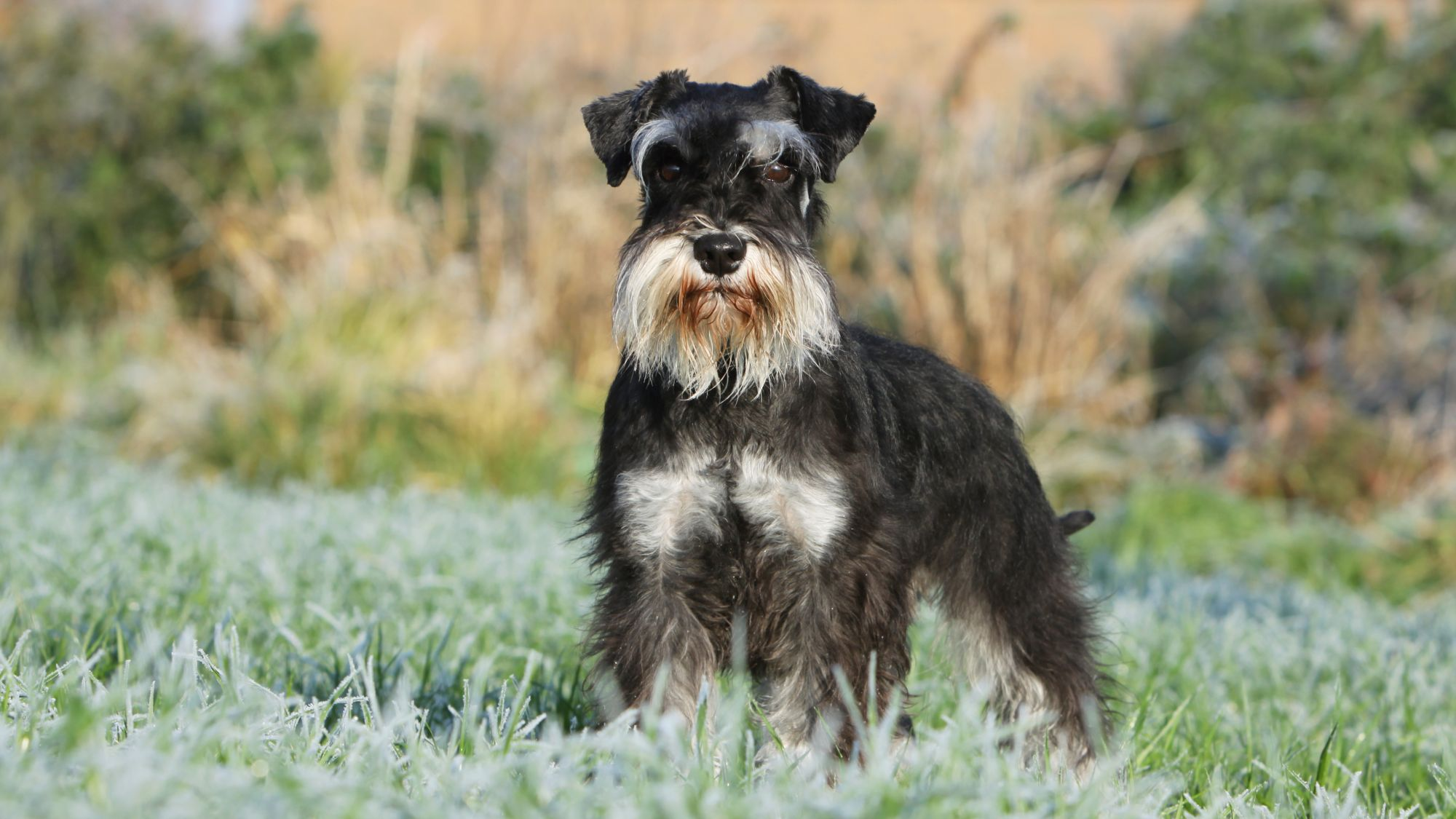
Get to know the Miniature Schnauzer
All you need to know about the breed
Quizzical eyebrows and a bushy beard give the Miniature Schnauzer the look of a distinguished old gentleman even when young – they’re just missing the silk waistcoat and the pocketwatch. The smallest member of the Schnauzer family shares his distinctive features and thick wiry coat with Standard and Giant Schnauzer varieties. But Miniature Schnauzers’ manageable size and alert nature, adaptability and ability to get on with other animals and children, once trained of course, have made them an even more popular choice – and a family favourite.
This stocky little dog originated in Germany in the late 19th century, when Standard Schnauzers were crossed with other, smaller breeds. Miniature Schnauzers are intelligent, lively and sociable – and they make excellent guard dogs. Yes, you read that correctly. Their tendency to bark, which can be corrected with early training, can have its advantages.
Miniature Schnauzers need to be taken out for regular exercise. Playful and tenacious by nature, in a good way, they enjoy playing games and learning tricks.
The dogs’ abundant coats can be black, white, black and silver or salt and pepper. To keep them in good condition, Miniature Schnauzers need regular trips to a professional groomer as well as basic brushing at home – AKA the perfect excuse for cuddles.
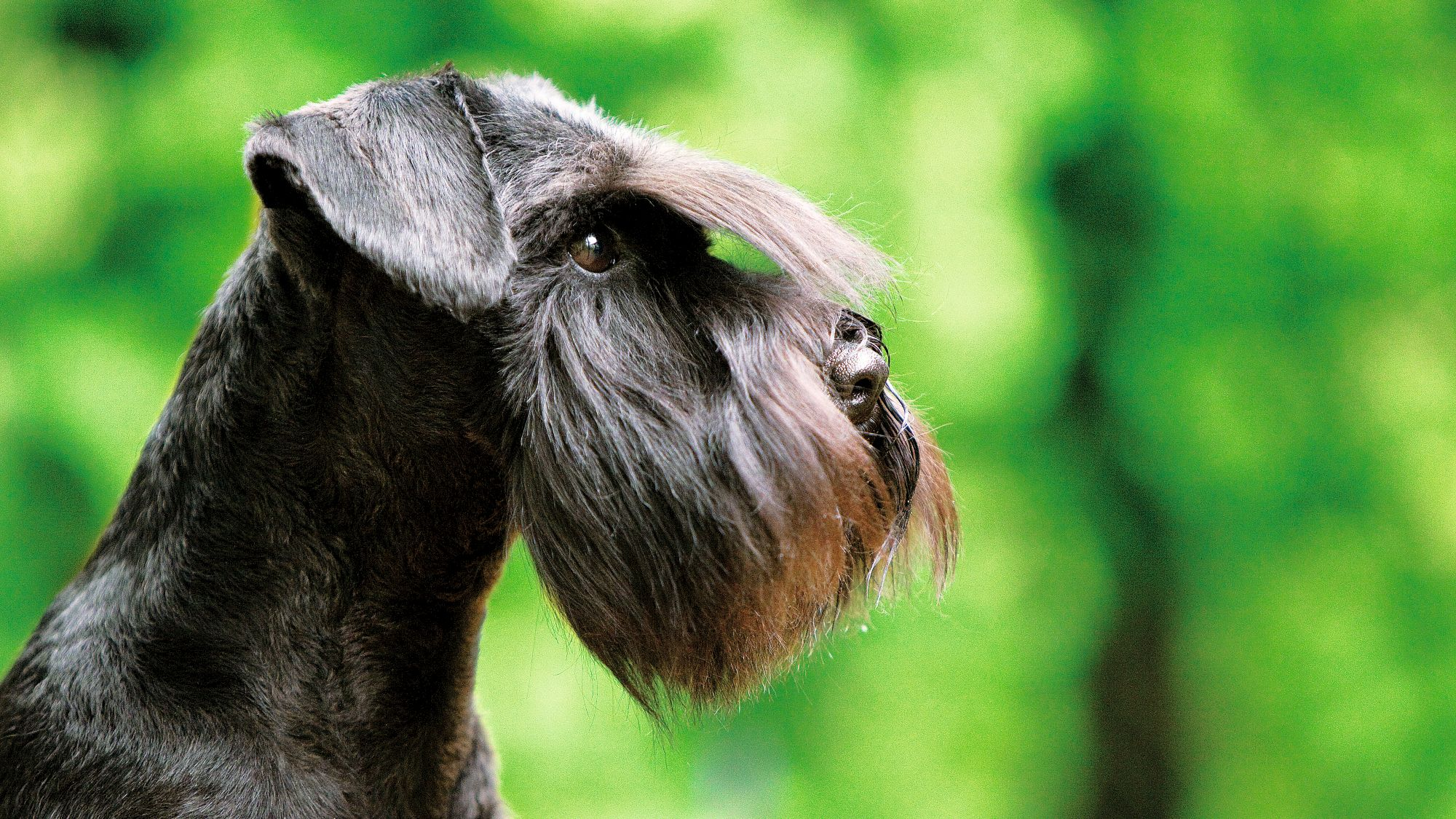
2 facts about Miniature Schnauzers
1. Prey Instinct
Miniature Schnauzers were originally bred as farm dogs to catch rats and other vermin. If smaller animals are around, it’s a good idea (particularly for the smaller animals) to keep them on the lead!
2. Popularity Contest
Shhh... don’t tell the others, but Miniature Schnauzers are the most popular member of the Schnauzer family. Perhaps it’s their more colourful coats or their more manageable size, but the Miniature Schnauzer is the runaway favourite of the three breeds according to The American Kennel Club’s latest ranking.
History of the breed
The Miniature Schnauzer shares their long moustache and square-jawed, bearded appearance with their ancestor, the Standard Schnauzer. For the whole Schnauzer family, it’s all about that beardy muzzle, which gives the breed its name, from the German “Schnauze” for muzzle. The Standard size originated in Germany at least as far back as the 14th century. It was developed to work as a farm dog, catching rats and other vermin, and was originally known as the Wire-Haired Pinscher.
The Miniature Schnauzer came about through crossing with poodles, Affenpinschers, miniature pinschers or even fox terriers and Scottish terriers – nobody is entirely sure which. Or why. But while this doggy cocktail’s exact origins are not clear, what we do know is that the Miniature Schnauzer breed was first officially recorded in 1888 in Germany and first shown at a dog show as a breed in its own right in 1899. It has since evolved into a modern family favourite.
From head to tail
Physical characteristics of Miniature Schnauzers
1.Ears
2.Face
3.Coat
4.Fur
5.Tail

Things to look out for
From specific breed traits to a general health overview, here are some interesting facts about your Miniature Schnauzer
Staying Fit As A Fiddle
Even if they are known to be generally robust dogs, there are a few health issues Miniature Schnauzers can be prone to, such as certain eye diseases, including – extremely rarely – congenital cataracts, which can develop later in life. Regular check-ups with the vet will ensure that your Miniature Schnauzer stays on top form and any health concerns are spotted and can be treated quickly.
On The Scales
Miniature Schnauzers can have a tendency towards being overweight, particularly if they are neutered. Their weight needs to be monitored regularly, as with any small dog. Following the recommended daily kibble amounts for the breed will help ensure that they maintain that lively and energetic temperament. While they can live contentedly in an apartment, Miniature Schnauzers do need plenty of exercise, and a good mix of walking, running and playing – for mental stimulation as well as burning off physical energy.
Healthy diet, healthier dog
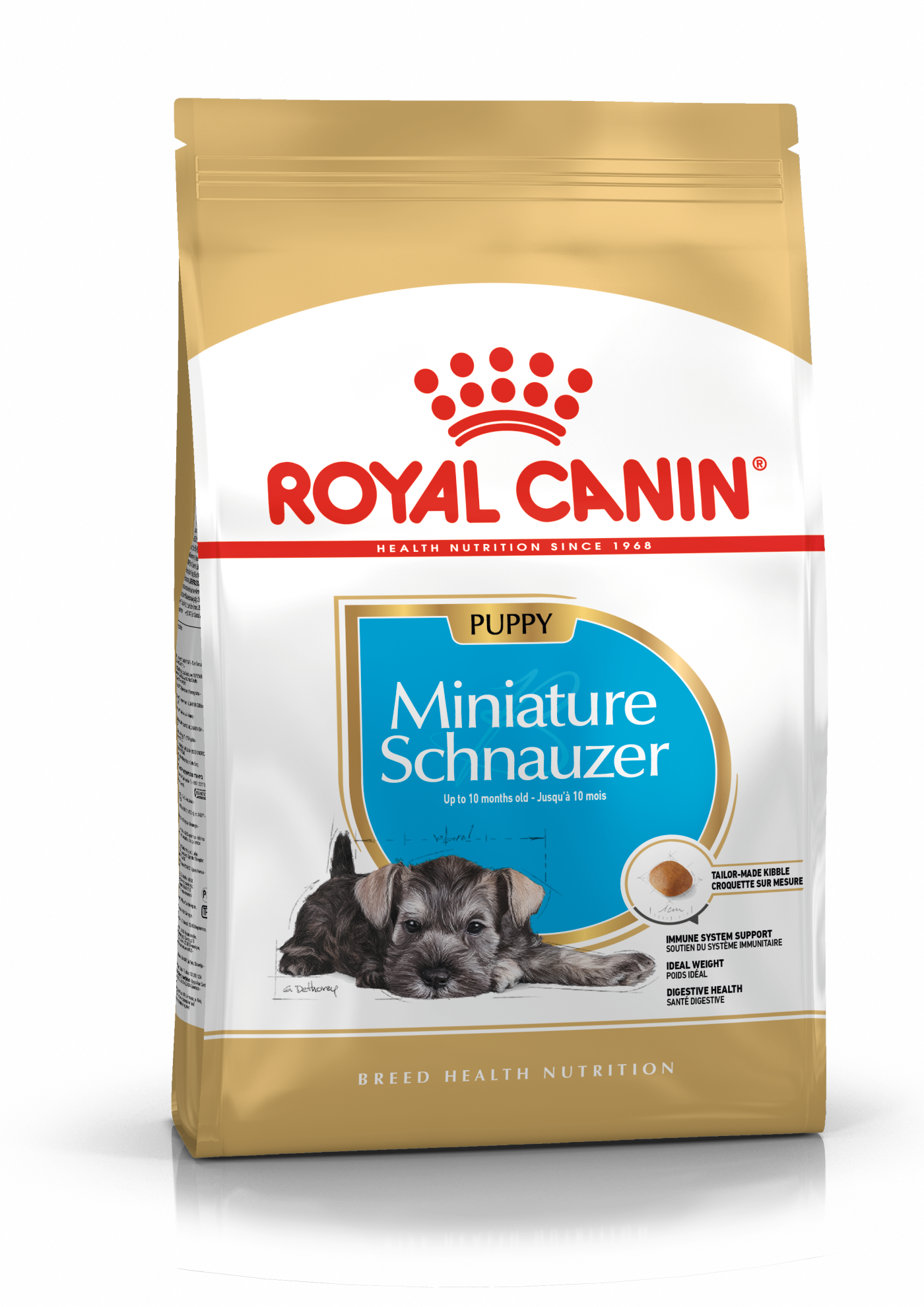
When choosing food for a Miniature Schnauzer, there are many factors to consider: their age, lifestyle, activity level, physiological condition, and health including potential sickness or sensitivities. Food provides energy to cover a dog’s vital functions, and a complete nutritional formula should contain an adjusted balance of nutrients to avoid any deficiency or excess in their diet, both of which could have adverse effects on the dog. Clean and fresh water should be available at all times to support good urinary regularity. In hot weather and especially when out exercising, bring water along for your dog’s frequent water breaks. The following
recommendations are for healthy animals. If your dog has health problems,
please consult your veterinarian who will prescribe an exclusively veterinary
diet.
A Miniature Schnauzer puppy’s requirements, in terms of energy, protein, minerals and vitamins, are much greater than those of an adult dog. They need energy and nutrients to maintain their body, but also to grow and build it. Until they are 10 months old, a Miniature Schnauzer puppy’s immune system develops gradually. A complex of antioxidants – including vitamin E – can help support their natural defences during this time of big changes, discoveries, and new encounters. Their digestive functions are different from an adult Miniature Schnauzer’s, too: their digestive system is not mature yet so it’s important to provide highly digestible proteins that will be effectively used. Prebiotics such as fructo-oligosaccharides support digestive health by helping balance the intestinal flora, resulting in good stool.
Similarly, a puppy’s teeth – starting with the milk teeth, or first teeth, then the permanent teeth – are an important factor that needs to be taken into account when choosing the size, form, and hardness of kibble. This intense growth phase also means high energy needs, so the food must have a high energy content (expressed in Kcal/100g of food), while concentrations of all other nutrients will also be higher than normal in a specially formulated growth food. It is recommended to split the daily allowance into three meals until they are six months old, then to switch to two meals per day.
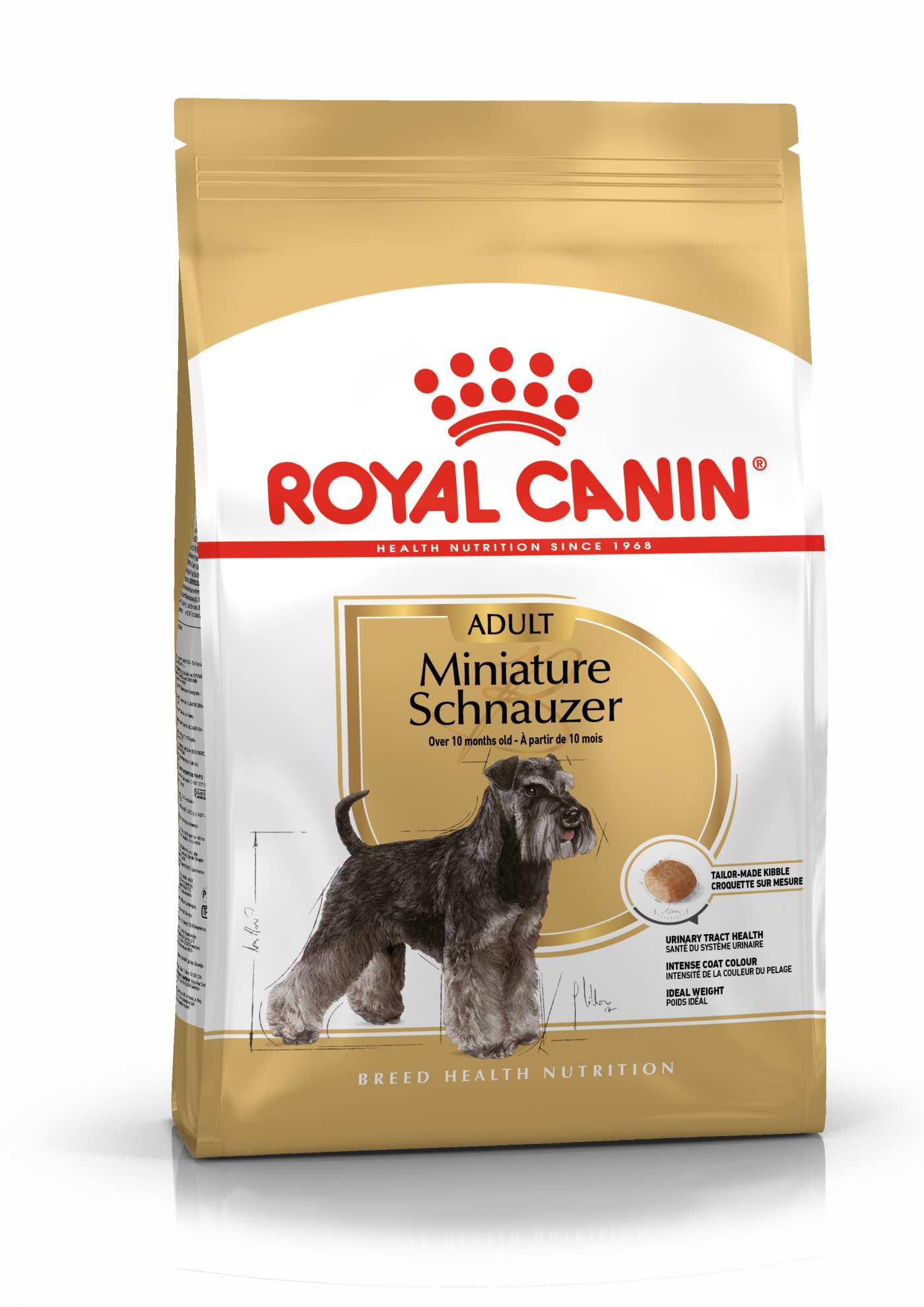
The main nutritional goals for adult Miniature Schnauzers are:
Maintaining an ideal body weight by using highly digestible ingredients and keeping the fat content at a sensible level.
Preserving the health and beauty of the skin and coat with the enriched addition of essential fatty acids (especially EPA-DHA), essential amino acids, and B vitamins.
At adult age, small breed dogs are exposed to oral and dental disorders, more precisely, accumulation of dental plaque and tartar. The Miniature Schnauzer’s teeth and jaws need a lot of protection. A kibble shape and a texture designed to promote chewing can help in slowing down the formation of dental plaque, and a formula containing calcium chelators can help reduce tartar formation, hence helping to support daily oral hygiene. Small breed dogs are well known for being fussy eaters. Exclusive formula and flavourings, as well as a kibble size with a special texture, will stimulate their appetite. Small breed dogs are prone to urinary stones; a diet that supports a healthy urinary system is recommended.
For Miniature Schnauzers living mainly indoors, highly digestible proteins, an appropriate fibre content, and very high quality carbohydrate sources will help reduce faecal smell and volume. Because an indoor lifestyle often means less exercise, an adapted calorie content, which meets the reduced energy needs, and a diet that contains L-carnitine, which promotes fat metabolism, can help maintain an ideal weight. It is important to avoid feeding them human foods or fatty snacks. Instead, reward your dog with kibble taken from their daily meal allowance, and strictly follow the feeding guidelines written on the package in order to prevent excessive weight gain.
For Miniature Schnauzers living mainly indoors, highly digestible proteins, an appropriate fibre content, and very high quality carbohydrate sources will help reduce faecal smell and volume. Because an indoor lifestyle often means less exercise, an adapted calorie content, which meets the reduced energy needs, and a diet that contains L-carnitine, which promotes fat metabolism, can help maintain an ideal weight. It is important to avoid feeding them human foods or fatty snacks. Instead, reward your dog with kibble taken from their daily meal allowance, and strictly follow the feeding guidelines written on the package in order to prevent excessive weight gain.
For Miniature Schnauzers living mainly indoors, highly digestible proteins, an appropriate fibre content, and very high quality carbohydrate sources will help reduce faecal smell and volume. Because an indoor lifestyle often means less exercise, an adapted calorie content, which meets the reduced energy needs, and a diet that contains L-carnitine, which promotes fat metabolism, can help maintain an ideal weight. It is important to avoid feeding them human foods or fatty snacks. Instead, reward your dog with kibble taken from their daily meal allowance, and strictly follow the feeding guidelines written on the package in order to prevent excessive weight gain.
For Miniature Schnauzers living mainly indoors, highly digestible proteins, an appropriate fibre content, and very high quality carbohydrate sources will help reduce faecal smell and volume. Because an indoor lifestyle often means less exercise, an adapted calorie content, which meets the reduced energy needs, and a diet that contains L-carnitine, which promotes fat metabolism, can help maintain an ideal weight. It is important to avoid feeding them human foods or fatty snacks. Instead, reward your dog with kibble taken from their daily meal allowance, and strictly follow the feeding guidelines written on the package in order to prevent excessive weight gain.

After 8 years old, Miniature Schnauzers start facing the first signs of ageing. A formula enriched with antioxidants will help maintain their vitality and an adapted phosphorous content will support their renal system. Ageing is also accompanied by the modification of digestive capacities and particular nutritional requirements, so food for older Miniature Schnauzers should have the following characteristics:
Higher vitamin C and E content. These nutrients have antioxidant properties, helping to protect the body’s cells against the harmful effects of the oxidative stress linked to ageing.
High-quality protein. Contrary to a widely held misconception, lowering the protein content in food brings little benefit in limiting kidney failure. In addition, older dogs are less efficient at using dietary protein than younger dogs. Reducing the phosphorous content is a good way of slowing down the gradual deterioration of kidney function.
A higher proportion of the trace elements iron, zinc, and manganese to help maintain the good condition of the skin and coat.
A higher quantity of polyunsaturated fatty acids to help maintain the quality of the coat. Dogs can normally produce these fatty acids, but ageing can affect this physiological process.
As they age, dogs increasingly suffer from teeth problems. To ensure they continue to eat in sufficient quantities, the shape, size, and hardness of their kibble needs to be tailored to their jaw.
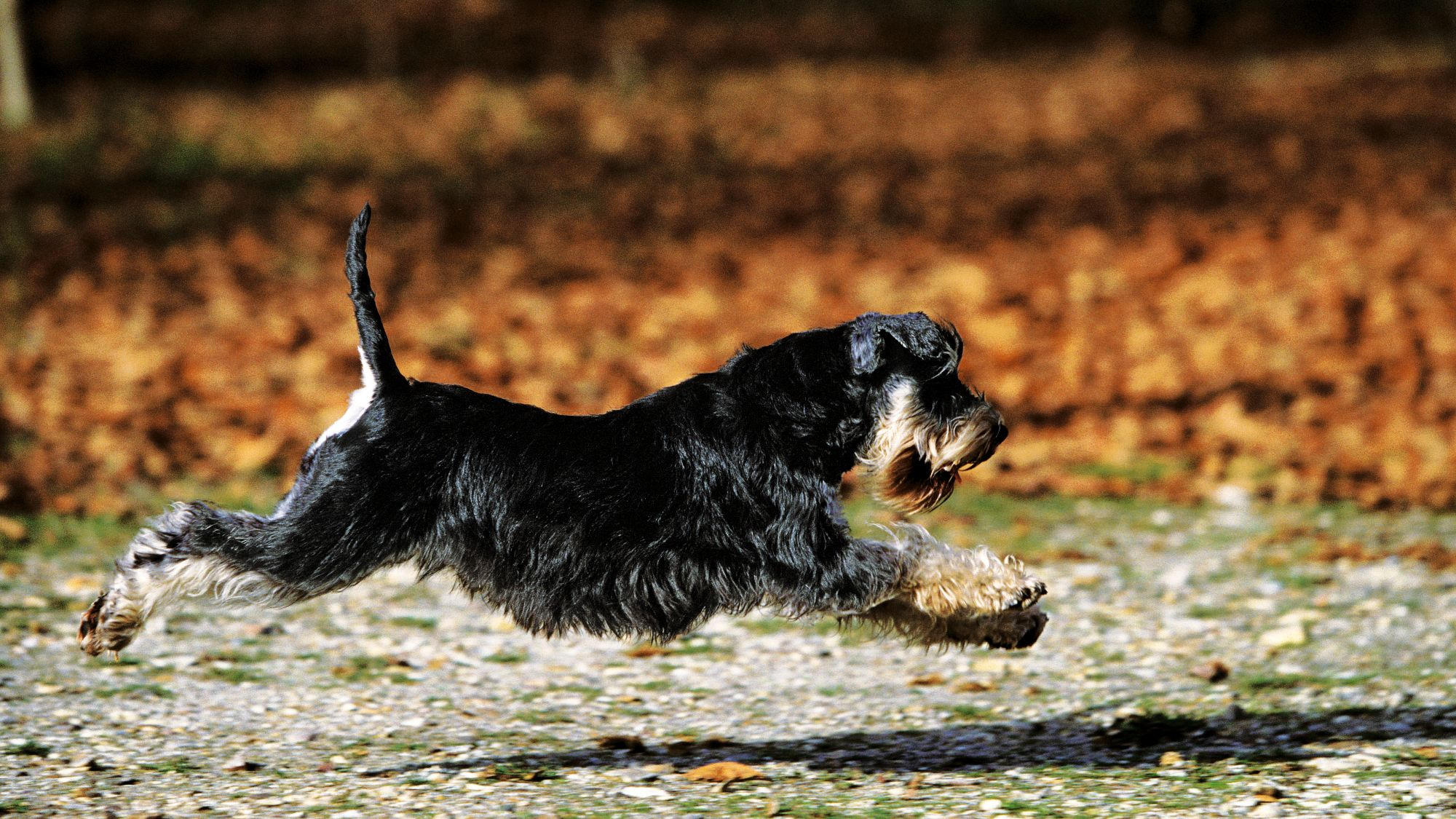
Caring for your Miniature Schnauzer
Grooming, training and exercise tips
7/7
All about Miniature Schnauzers
Miniature Schnauzers are a lively and active breed and sometimes they just can’t help sharing their excitement with a bark or two. While for a guard dog that can be an asset, if your Miniature Schnauzer is a bit more vocal than you would like, early training can help.
Don’t be fooled by the hipster beard: Miniature Schnauzers might look hairy but they actually shed very little.
Other breeds that might interest you
Read more on this topic
Sources
- Veterinary Centers of America https://vcahospitals.com/
- Royal Canin Dog Encyclopaedia. Ed 2010 and 2020
- Banfield Pet Hospital https://www.banfield.com/
- Royal Canin BHN Product Book
- American Kennel Club https://www.akc.org/
Like & share this page